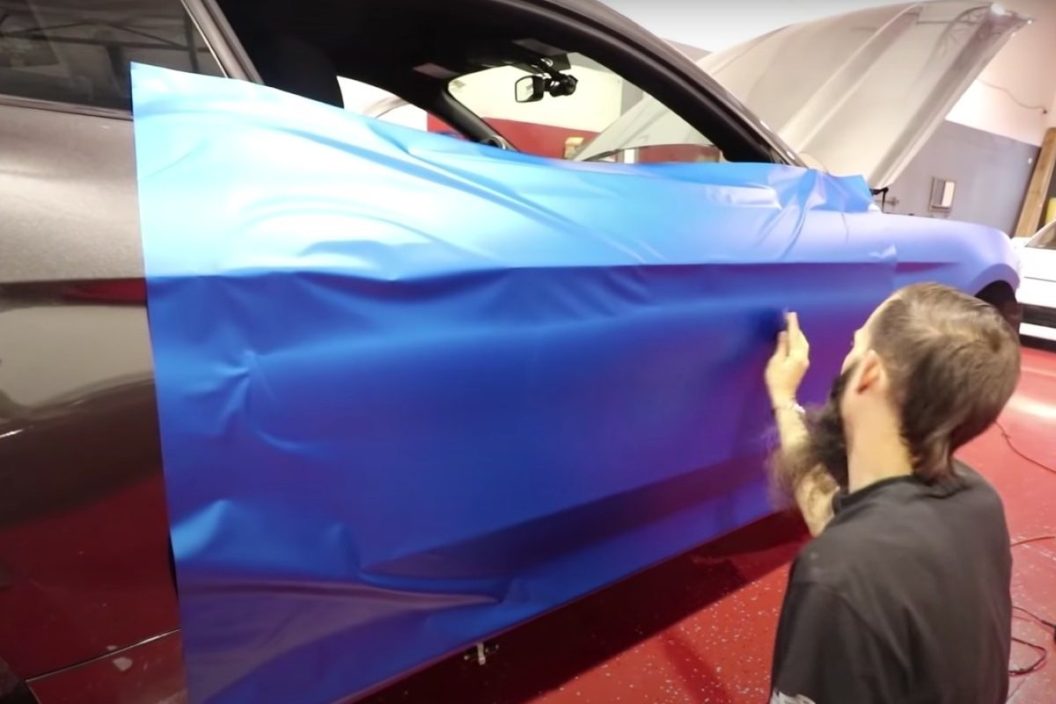If you've ever considered changing the color of your vehicle, you've probably had to question whether or not you should paint your vehicle, or throw on a vinyl car wrap. Each has their advantages, but there's a number of different reasons why you should pick a vinyl wrap over a full-on paint job.
As an automotive do-it-yourself project, the whole car wrapping job is a lot cheaper than you might think, especially when compared to what a professional installer will charge you. You can pick up quality vinyl film off Amazon, and if you know the tricks to applying it, you can switch up the color of your car in no time, without breaking the bank.
Vinyls come in all types of different colors, including high gloss, matte, and carbon fiber vinyl wrap textures. Whatever color of paint that you like, you should be able to find something extremely similar with vinyl. For all the first-timers out there, we're going to go over the process of how to properly lay down a wrap job, and hopefully, it can save you a little time and headache along the way.
Breaking Down the Steps for That DIY Car Wrap Project
Preparation
Take a look around the entire car that you're planning on vinyl wrapping. It's very important that the body panels and paint job have a smooth finish on them. Light scratches are alright, but if you find dents, chips, rust, or gouges, it can bubble or tear the wrap, so it's best to take care of these blemishes beforehand, so you have a smooth surface to work with.
This is a lengthy process, so you'll need to figure out where to park your car. A garage would be the most ideal, however, the main object is getting away from any dirt, dust, or bugs that can mess up the finish. Additionally, you'll want to make sure you're working on a warmer day. The vinyl adhesive is temperature sensitive, and you can use a non-contact infrared thermometer to make sure it's around 68°F. Any colder, and the wrap will tear too easy. Any hotter, and it will be too hard to apply smoothly.
It's best to get all your tools and materials together before starting. You'll need your roll of vinyl wrap, grease or wax remover, a surface cleaner, squeegee, isopropyl alcohol, lint-free cloths, utility knife, heat gun, and some cotton gloves for the most part. If you have a spare friend available, this project is also much easier with someone that can help, although it's not necessarily required.
Surface Prep
Start the process by giving your car a nice overall wash with a non-wax car wash product. This will leave a nice smooth surface for the vinyl to bond to. You can then wipe it down with some isopropyl alcohol and a lint-free cloth to ensure no dirt will be trapped underneath.
In order to make things easier, it's best to remove certain trim items from the body panels. Everything from the emblems, door handles, antenna, and lights can be taken off to create a much flatter surface for the vinyl to lay on. You could lay the vinyl sheet over these trim pieces and work around it, but it will be a much more tedious process that way. After removal, give another wipe down with alcohol.
Measure each of the panels that you're going to be wrapping, and draw up a template with all the measurements so you know what you're working with. When it comes to actually cutting the vehicle wrap for each panel, make sure you cut it with extra length on all sides. The wrap will shrink a bit during installation.
Laying the Vinyl Wrap
If this is your first time doing vehicle wrapping, you'll want to start with some of the easier flatter panels to get a feel for the process. Here's where you'll want to have a friend to help you out. Vinyl is basically like a sticker, so while keeping the vinyl in the air above the panel, keep tension on it, and remove the backing paper. Keeping tension will help reduce the number of creases in the vinyl when you lay it down.
You'll want to begin laying the vinyl from the center and work your way outward. Gently press it onto the center while keeping tension on the rest of the sheet. Using the squeegee, you can smooth it out and work your way toward the edges of the panel. As the air releases from under the vinyl, it will temporarily adhere.
As you work, you may notice some air bubbles or wrinkles forming. To fix this, simply lift up the edge of the vinyl closest to the blemish, and apply some heat with the heat gun. Stretch the layer back out, and smooth it all out with the squeegee once again, and you should be bubble free. This is a tedious process, however, just take your time to make sure everything lays smooth, and apply heat when you need it. Just be sure not to overheat the vinyl layer.
When you make your way to the edges, you can cut the excess material with some cutters or a sharp blade. Leave just a little bit of overhang, and tuck it under the edges to finish up with a clean look. Use your fingers on the squeegee to make sure it sticks flush underneath the edge. Finally, just apply more heat over the entire panel to fully activate the adhesive material. Take it one panel at a time, but before you know it, you'll have the whole car wrapped like a professional detailer. It's the perfect at-home DIY project.
Products featured on Alt_driver are independently selected by our editors. However, when you buy something through our links, we may earn a commission.
This post was originally published on December 1, 2020.
